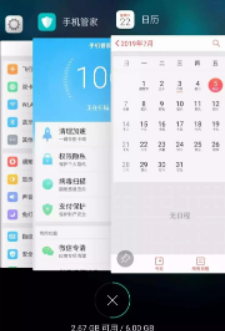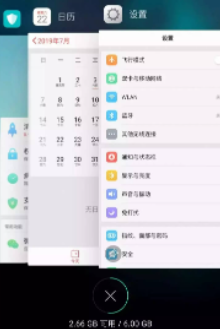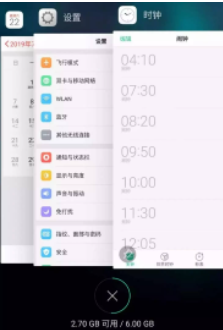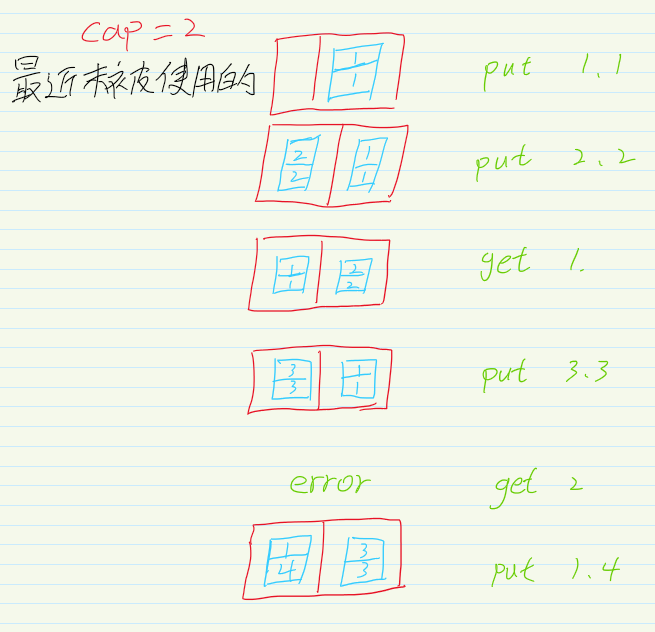LRU 缓存实现
使用 C++ 和 Go 实现 LRU 缓存
LRU 缓存介绍
LRU 是 Least Recently Used,就是最近使用过的数据最有可能会继续使用的。很长时间没有用过的数据就认为是之后不会再用到了。在容量有限的情况下,如果数据存满了,又有新的数据过来了。那么就要把最久没被使用的给删了。
LeeCode 上有个老哥举例很生动
举个简单的例子,安卓手机都可以把软件放到后台运行,比如我先后打开了「设置」「手机管家」「日历」,那么现在他们在后台排列的顺序是这样的:
但是这时候如果我访问了一下「设置」界面,那么「设置」就会被提前到第一个,变成这样:
假设我的手机只允许我同时开 3 个应用程序,现在已经满了。那么如果我新开了一个应用「时钟」,就必须关闭一个应用为「时钟」腾出一个位置,关那个呢?
按照 LRU 的策略,就关最底下的「手机管家」,因为那是最久未使用的,然后把新开的应用放到最上面:
LRU 的操作
对于一个 LRU 缓存来说都是有一个缓冲区的大小 (capacity),可以向缓存中放数据 put(key,val),也可以从缓存中拿到数据 get(key),注意在 put 和 get 的时候都是 O(1) 的时间复杂度。
/缓存容量为 2/ LRUCache cache = new LRUCache(2); // 你可以把 cache 理解成一个队列 // 假设左边是队头,右边是队尾 // 最近使用的排在队头,久未使用的排在队尾 // 圆括号表示键值对 (key, val)
cache.put(1, 1); // cache = [(1, 1)]
cache.put(2, 2); // cache = [(2, 2), (1, 1)]
cache.get(1); // 返回 1 // cache = [(1, 1), (2, 2)] // 解释:因为最近访问了键 1,所以提前至队头 // 返回键 1 对应的值 1
cache.put(3, 3); // cache = [(3, 3), (1, 1)] // 解释:缓存容量已满,需要删除内容空出位置 // 优先删除久未使用的数据,也就是队尾的数据 // 然后把新的数据插入队头
cache.get(2); // 返回 -1 (未找到) // cache = [(3, 3), (1, 1)] // 解释:cache 中不存在键为 2 的数据
cache.put(1, 4); // cache = [(1, 4), (3, 3)] // 解释:键 1 已存在,把原始值 1 覆盖为 4 // 不要忘了也要将键值对提前到队头
LRU 的设计
根据上述的描述,对于 put 和 get 为 O(1) 的时间复杂度的数据结构要进行设计
- 题目中有"最近使用",就说明数据是有序的,这个有序是相对于使用的时间而言的
- 要在某个位置进行 O(1) 的插入
- 查找也是 O(1)
要同时满足以上的条件单一的数据结构肯定是不行的。对于查找是来说可以使用哈希表来满足条件,有序可以使用链表,但是要进行 O(1) 的插入,就要使用双链表了,单链表不能进行 O(1) 的时间复杂度的插入。
LRU 缓存算法的核心数据结构就是哈希链表,双向链表和哈希表的结合体。这个数据结构长这样:
借助这个结构,我们来逐一分析上面的 3 个条件:
1、如果我们每次默认从链表尾部添加元素,那么显然越靠尾部的元素就是最近使用的,越靠头部的元素就是最久未使用的,如果容量满了之后,要删的也是删除头部的。
2、对于某一个 key,我们可以通过哈希表快速定位到链表中的节点,从而取得对应 val,也就是哈希表存的是值所对应的结点的地址,通过这个地址就可以拿到对应的 val。
3、链表显然是支持在任意位置快速插入和删除的,改改指针就行。只不过传统的链表无法按照索引快速访问某一个位置的元素,而这里借助哈希表,可以通过 key 快速映射到任意一个链表节点,然后进行插入和删除。
也许读者会问,为什么要是双向链表,单链表行不行?另外,既然哈希表中已经存了 key,为什么链表中还要存 key 和 val 呢,只存 val 不就行了?
想的时候都是问题,只有做的时候才有答案。这样设计的原因,必须等我们亲自实现 LRU 算法之后才能理解,所以我们开始看代码吧~
代码实现
c++
虽然系统中实现了双向链表,但是这里还是想自己实现一遍。
实现 Node
struct Node{
int key;
int val;
Node *pre; // 指向之前的结点
Node *next;// 指向之后的结点
Node(int key,int val):key(key),val(val){}
}
实现双向链表
struct DoubleList{
private:
Node *head; // 头结点,不存数据
Node *tail; // 尾结点,不存数据
int size; // 元素的个数
public:
DoubleList(){
head = new Node(0,0);
tail = new Node(0,0);
size = 0;
head->next = tail; // 头结点的 next 指向尾结点
tail->pre = head; // 尾结点的 pre 指向头结点
}
// 在尾部添加元素
void addTail(Node *x){
x->pre = tail->pre; // 插入的之前的指向尾巴的前结点
x->next = tail; // 插入的 next 指向尾结点
tail->pre->next = x; // 尾巴之前的结点的 next 指向 x
tail->pre = x; // 尾巴之前的变为 x
size++;
}
// 移除某个结点
void remove(Node *x) {
x->pre->next = x->next;
x->next->pre = x->pre;
size--;
}
// 移除头结点
Node *removeFirst() {
if (head == nullptr) {
return nullptr;
}
Node *first = head->next;
remove(first);
return first;
}
int len() {
return size;
}
}
到这里就能回答刚才「为什么必须要用双向链表」的问题了,因为我们需要删除操作。删除一个节点不光要得到该节点本身的指针,也需要操作其前驱节点的指针,而双向链表才能支持直接查找前驱,保证操作的时间复杂度 O(1)。
注意我们实现的双链表 API 只能从尾部插入,也就是说靠尾部的数据是最近使用的,靠头部的数据是最久为使用的。
实现 LRU
LRU 中要使用到之前实现的链表和哈希表。
struct LRU {
map<int, Node *> *m;
DoubleList *cache;
int cap;
// 初始化
LRU(int cap) {
this->cap = cap;
m = new map<int, Node *>;
cache = new DoubleList();
}
// 封装底层的接口
private:
// 将某个 key 提升为最近使用的
void makeRecently(int key) {
auto item = m->find(key);
if (item == m->end()) {
return;
}
// 先删除
cache->remove(item->second);
// 再加到链表的尾部
cache->addLast(item->second);
}
// 添加最近使用过的元素
void addRecently(int key, int val) {
Node *x = new Node(key, val);
// 添加到尾部
cache->addLast(x);
// 在 map 中也要添加
m->insert(pair<int, Node *>(key, x));
}
// 删除某个缓存
void deleteKey(int key) {
auto temp = m->find(key);
// 如果没有找到就算了
if (temp == m->end()) {
return;
}
// 在链表和 map 中都删除
cache->remove(temp->second);
m->erase(key);
}
// 删除最久没被使用的
void removedLeastRecently() {
// 链表删除头
Node *deleteNode = cache->removeFirst();
// map 直接删除
m->erase(deleteNode->key);
}
// 封装对外的 get 和 set
public:
int get(int key) {
auto temp = m->find(key);
if (temp == m->end()) {
return -1;
}
// 找到之后要提升
makeRecently(key);
return temp->second->val;
}
void put(int key, int val) {
auto temp = m->find(key);
// 如果找到了 就是要修改值
if (temp != m->end()) {
// 先删除 key
deleteKey(key);
// 再添加
addRecently(key, val);
return;
}
// 容量超了就删除最久没有使用的
if (cap == cache->len()) {
removedLeastRecently();
}
addRecently(key, val);
}
};
c++ 另一个版本
使用 iterator 迭代器进行实现
class LRUCache {
public:
LRUCache(int capacity) : cap(capacity) {
}
int get(int key) {
// 如果没有就返回 -1
if (map.find(key) == map.end()) return -1;
auto keyAndValue = *map[key];
cache.erase(map[key]);
cache.push_front(keyAndValue);
map[key] = cache.begin();
return keyAndValue.second;
}
void put(int key, int value) {
// 如果缓存中没有
if (map.find(key) == map.end()) {
// 缓存中满了
if (cache.size() == cap) {
// 删除头部的元素,也就是最久没被使用的
map.erase(cache.back().first);
cache.pop_back();
}
} else {
// 如果缓存中有就删除
cache.erase(map[key]);
}
// 重新插在末尾
cache.push_front({key, value});
map[key] = cache.begin();
}
private:
int cap;
// 一个双向链表,存顺序
list<pair<int, int>> cache;
// 加速访问
unordered_map<int, list<pair<int, int>>::iterator> map;
};
这个版本不用实现双向链表,只需要自己手动调用就行
go
和之前 c++1.0 版本一样自己实现一个双向链表,之后使用自带的 map。这次使用了 1.18 的泛型进行实现。
Node
// 通用的结点,保存的 val 可以是任何类型
type Node[T any] struct {
Val T
Pre *Node[T]
Next *Node[T]
}
func NewNode[T any](val T) *Node[T] {
return &Node[T]{
Val: val,
}
}
// 一个 key-value 的数据结构
type KeyValue[Key, Value any] struct {
Key Key
Value Value
}
double-list
// 链表的数据结构
// 使用的时候要给传入 Node 中 val 的类型
type DoubleList[T any] struct {
head *Node[T] // 头结点
tail *Node[T] // 尾巴结点
size int
}
func NewDoubleList[T any]() *DoubleList[T] {
dl := DoubleList[T]{
head: new(Node[T]),
tail: new(Node[T]),
size: 0,
}
dl.head.Next = dl.tail
dl.tail.Pre = dl.head
return &dl
}
// 在尾巴插入一个结点
func (dl *DoubleList[T]) PushBack(node *Node[T]) {
node.Pre = dl.tail.Pre
node.Next = dl.tail
dl.tail.Pre.Next = node
dl.tail.Pre = node
dl.size++
}
// 删除一个结点
func (dl *DoubleList[T]) Remove(node *Node[T]) {
if node == nil || node.Pre == nil || node.Next == nil {
return
}
node.Pre.Next = node.Next
node.Next.Pre = node.Pre
dl.size--
}
// 返回头结点
func (dl *DoubleList[T]) Front() *Node[T] {
if dl.head == nil {
return nil
}
return dl.head.Next
}
// 删除头结点
func (dl *DoubleList[T]) PopFront() {
if dl.head == nil {
return
}
dl.Remove(dl.head.Next)
return
}
// 返回链表长度
func (dl *DoubleList[T]) Size() int {
return dl.size
}
LRU 实现
var (
NotFoundErr = errors.New("not found")
)
// lru 的数据结构
type lru[K comparable, Value any] struct {
// lock sync.RWMutex
data map[K]*Node[KeyValue[K, Value]]
cache *DoubleList[KeyValue[K, Value]]
cap int
}
func NewLRU[K comparable, Value any](cap int) *lru[K, Value] {
return &lru[K, Value]{
data: make(map[K]*Node[KeyValue[K, Value]]),
cache: NewDoubleList[KeyValue[K, Value]](),
cap: cap,
}
}
// 提升某个结点
func (lru *lru[K, Value]) makeRecently(key K) {
find, ok := lru.data[key]
if !ok {
return
}
lru.cache.Remove(find)
lru.cache.PushBack(find)
}
// 新添加一个结点
func (lru *lru[K, Value]) addRecently(key K, value Value) {
node := NewNode[KeyValue[K, Value]](KeyValue[K, Value]{Key: key, Value: value})
lru.cache.PushBack(node)
lru.data[key] = node
}
// 删除某个结点
func (lru *lru[K, Value]) deleteKey(key K) {
find, ok := lru.data[key]
if !ok {
return
}
lru.cache.Remove(find)
delete(lru.data, key)
}
// 删除最久没有使用的
func (lru *lru[K, Value]) removerLeastRecently() {
head := lru.cache.Front()
lru.cache.PopFront()
delete(lru.data, head.Val.Key)
}
// Put
func (lru *lru[K, Value]) Put(key K, val Value) {
_, ok := lru.data[key]
if ok {
lru.deleteKey(key)
}
if lru.cap == lru.cache.Size() {
lru.removerLeastRecently()
}
lru.addRecently(key, val)
}
// Get
func (lru *lru[K, Value]) Get(key K) (Value, error) {
find, ok := lru.data[key]
if !ok {
var t Value
return t, NotFoundErr
}
lru.makeRecently(key)
return find.Val.Value, nil
}




